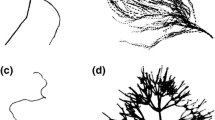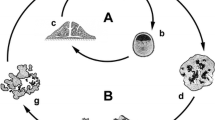Abstract
The growth form of the sponge Haliclona oculata is to a significant extent determined by the environmental conditions in which the form emerges. One of the main environmental parameters affecting the growth form is exposure to water movement. In this study, a morphological growth model is used to simulate the effect on the growth process of a change in exposure to water movement. Predictions based on the model are verified by experiments in which sponges from a sheltered growth site are transplanted to an exposed site, and vice versa. The effect of the transplantation on growth forms is determined by morphological comparisons. By combining the morphological simulation model with interpretation of growth forms, it becomes possible to use the growth form of H. oculata for bio-monitoring purposes. This form reflects the environmental conditions governing the growth process.
Similar content being viewed by others
Literature cited
Barthel, D. (1991). Influence of different current regimes on the growth form of Halichondria panicea Pallas. In: Reitner, J., Keupp, H. (eds.) Fossil and recent sponges. Springer-Verlag, Berlin, p. 387–394
Bidder, G. P. (1923). The relation of the form of a sponge to its currents. Q. Jl microsc. Sci. 67: 293–323
Brien, P., Lévi, C., Sara, M., Tuzet, O., Vacelet, J. (1973). Traité de zologie, anatomie, systématique, biologie, Tome III Spongiares, fascicule 1. Masson et Cie Editeurs, Paris
de Kluijver, M. J. (1989). Sublittoral hard substrate communities of the Southern Delta area, SW Netherlands. Bijdr. Dierk. 59: 141–158
de Weerdt, W. H. (1981). Transplantation experiments with caribbean Millepora species (Hydrozoa, Coelenterata), including some ecological observations on growth forms. Bijdr. Dierk. 51: 1–19
Fujikawa, H., Matsushita, M. (1989). Fractal growth of Bacillus subtilis on agar plates. J. phys. Soc. Japan 58: 3875–3878
Graus, R. R. (1977). Investigation of coral growth adaptations using computer modeling. In: Taylor, D. L. (ed.) Proceedings of the third international coral reef symposium, Vol. II. Rosenthiel School of Marine and Atmospheric Sciences, Miami, p. 463–469
Graus, R. R., Macintyre, I. G. (1982). Variation in growth forms of the reef coral Montastrea annularis (Ellis and Solander): a quantitative evaluation of growth response to light distribution using computer simulation. Smithson. Contr. mar. Sci. 12: 441–464
Kaandorp, J. A. (1991a). Modelling growth forms of sponges with fractal techniques. In: Crilly, A. J., Earnshaw, R. A., Jones, H. (eds.) Fractals and chaos. Springer-Verlag, Berlin, p. 181–196
Kaandorp, J. A. (1991b). Modelling growth forms of the sponge Haliclona oculata (Porifera; Demospongiae) using fractal techniques. Mar. Biol. 110: 203–215
Lindenmayer, A. (1968). Mathematical models for cellular interactions in development. J. theor. Biol. 18: 280–299
Matsuyama, T., Sogawa, M., Nakagawa, Y. (1989). Fractal spreading growth of Serratia marcescens which produces surface active exolipids. Fedn eur. microbiol. Soc. (FEMS) Lett. 61: 243–246
Nakamori, T. (1988). Skeletal growth model of the dendritic hermatypic corals limited by light shelter effect. In: Choat, J. H., et al. (ed.) Proceedings of the 6th International Coral Reef Symposium, Vol. III. Sixth International Symposium Executive Committee, Townsville, p. 113–118
Prusinkiewicz, P., Lindenmayer, A. (1990). The algorithmic beauty of plants. Springer-Verlag, Berlin
Sander, L. M. (1986). Fractal growth processes. Nature, Lond. 322: 789–793
Stanley, H. E., Ostrowsky, N. (1987). On growth and form: fractal and non-fractal patterns in physics. Martinus Nijhoff, Boston
Vogel, S. (1983). Life in moving fluids. Princeton University Press, Princeton
Vogel, S., Bretz, W. L. (1971). Interfacial organisms: passive ventilation in the velocity gradients near surfaces. Science, N.Y. 175: 210–211
Warburton, F. E. (1960). Influence of currents on form of sponges. Science, N.Y. 132: 89
Wiedenmayer, F. (1977). Shallow-water sponges of the western Bahamas. Birkhäuser Verlag, Basel
Witten, T. A., Sander, L. M. (1981). Diffusion-limited aggregation, a kinetic critical phenomenon. Phys. Rev. Lett. 47: 1400–1403
Author information
Authors and Affiliations
Additional information
Communicated by O. Kinne, Oldendorf/Lube
Rights and permissions
About this article
Cite this article
Kaandorp, J.A., de Kluijver, M.J. Verification of fractal growth models of the sponge Haliclona oculata (Porifera) with transplantation experiments. Marine Biology 113, 133–143 (1992). https://doi.org/10.1007/BF00367647
Accepted:
Issue Date:
DOI: https://doi.org/10.1007/BF00367647




